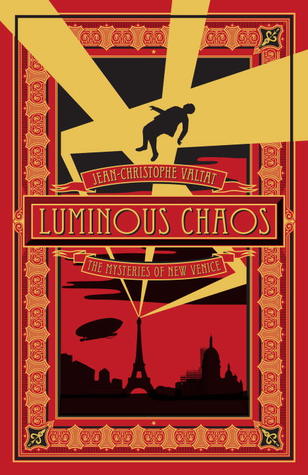
by by Margaret Kolb

Published by Melville House, 2013 | 528 pages
Luminous Chaos, the second volume in the Mysteries of New Venice trilogy, serves as both sequel and prequel to Valtat’s critically acclaimed Aurorarama. Whereas Aurorarama focused more on the highly stylized, Victorian world under portrayal, Luminous Chaos turns its focus to the portrayal of character. Shifting the scene from arctic New Venice to Paris, Valtat delivers another perplexing mélange of science fiction and steampunk technology.
Luminous Chaos begins roughly one year after Aurorarama, following Brenford Orsini’s successful coup of the corrupt Council of Seven and the end of his self-imposed one-year term as Regent Dodge, ruler of New Venice. After an unexpected electoral loss to a rival, Orsini is charged with a secret mission to set up a shadow embassy in Paris. Orsini selects the six people closest to him to accompany him – those central to the plot of Aurorarama. As the self-titled “Most Serene Seven” they depart for Paris.
In the world of Luminous Chaos, travel from New Venice occurs via an old and unstable technology called a "Psychomotive," an H.G. Wellsian vehicle powered by “Od,” a universal kinetic force. During their journey, the seven unintentionally travel back through time from 1907 A.B. – After Backwards – to 1895, a time before New Venice existed. Stationed in Paris, they begin the process of finding their way back to the future. In this alternative past, the magic of the pole, the Aurora above it, the fabric of the mind, and the spiritual protector of the arctic, the Kiggertarpoq (polar kangaroo) have conspired to encase the Paris of 1895 in a New Venetian winter, crippling the city and charging it with an anarchist energy.
The seven descend into Paris’ treacherous and lecherous underbelly, finding at its core none other than “The Seven Sleepers,” the eventual founders of New Venice. Over the course of Luminous Chaos, members of Orsini’s team indulge in drugs and affairs of the heart, and the memory of New Venice grows less and less clear. And yet, in the end, it is an ice-clear memory of New Venice that proves the key to their eventual return.
The cold, calculating brutality of Paris here, overrun with corrupt police, secret societies, black magic, and murder, reads in its juxtaposition to Aurorarama’s Victorian New Venice like a dull blade. This City of Darkness is a shadowy place, entirely devoid of the beauty and splendor of Aurorarama’s New Venice. The half constructed Eiffel tower is an eyesore, the partially constructed Sacre-Coeur “sinister and drafty,” a wasteland of snowy rubble and scaffolding. New Venice is very much still present in Luminous Chaos, of course, though it is so only in its absence. If in Aurorarama, Valtat’s New Venice invites the reader to gaze at every spire and linger under every archway, the New Venice of Luminous Chaos evokes a more mature affection, a place we long for, a place of exaggerated significance: a home.
As the middle child of the Mysteries of New Venice trilogy, Luminous Chaos serves as a bridge between the series’ enchanting beginning to what looks set to be a thundering conclusion. Valtat’s decision to move the scene of this novel from New Venice, the “pearl of the Arctic,” makes this novel a love letter to a frozen dream of a place that could never be, but is.
SD Allison was born in Nebraska. He is the descendant of farmers, teachers, and men with bad lungs. He is the father of a little boy with autism. His first novel, Beneath the Plastic, was published in 2006.















click to see who
MAKE Magazine Publisher MAKE Literary Productions Managing Editor Chamandeep Bains Assistant Managing Editor and Web Editor Kenneth Guay Fiction Editor Kamilah Foreman Nonfiction Editor Jessica Anne Poetry Editor Joel Craig Intercambio Poetry Editor Daniel Borzutzky Intercambio Prose Editor Brenda Lozano Latin American Art Portfolio Editor Alejandro Almanza Pereda Reviews Editor Mark Molloy Portfolio Art Editor Sarah Kramer Creative Director Joshua Hauth, Hauthwares Webmaster Johnathan Crawford Proofreader/Copy Editor Sarah Kramer Associate Fiction Editors LC Fiore, Jim Kourlas, Kerstin Schaars Contributing Editors Kyle Beachy, Steffi Drewes, Katie Geha, Kathleen Rooney Social Media Coordinator Jennifer De Poorter
MAKE Literary Productions, NFP Co-directors, Sarah Dodson and Joel Craig